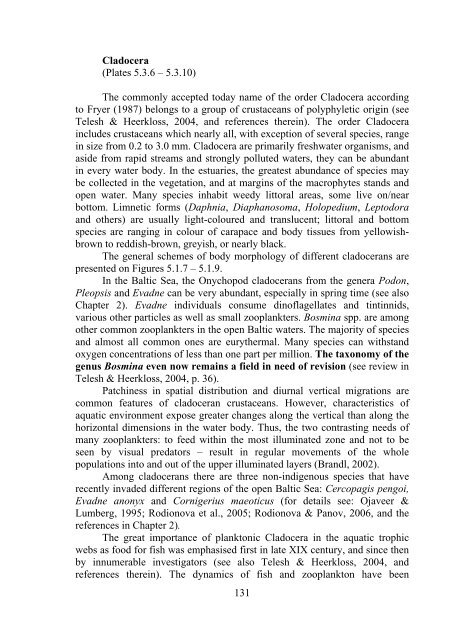Zooplankton of the open Baltic: Extended Atlas - IOW
Zooplankton of the open Baltic: Extended Atlas - IOW
Zooplankton of the open Baltic: Extended Atlas - IOW
Create successful ePaper yourself
Turn your PDF publications into a flip-book with our unique Google optimized e-Paper software.
Cladocera<br />
(Plates 5.3.6 – 5.3.10)<br />
The commonly accepted today name <strong>of</strong> <strong>the</strong> order Cladocera according<br />
to Fryer (1987) belongs to a group <strong>of</strong> crustaceans <strong>of</strong> polyphyletic origin (see<br />
Telesh & Heerkloss, 2004, and references <strong>the</strong>rein). The order Cladocera<br />
includes crustaceans which nearly all, with exception <strong>of</strong> several species, range<br />
in size from 0.2 to 3.0 mm. Cladocera are primarily freshwater organisms, and<br />
aside from rapid streams and strongly polluted waters, <strong>the</strong>y can be abundant<br />
in every water body. In <strong>the</strong> estuaries, <strong>the</strong> greatest abundance <strong>of</strong> species may<br />
be collected in <strong>the</strong> vegetation, and at margins <strong>of</strong> <strong>the</strong> macrophytes stands and<br />
<strong>open</strong> water. Many species inhabit weedy littoral areas, some live on/near<br />
bottom. Limnetic forms (Daphnia, Diaphanosoma, Holopedium, Leptodora<br />
and o<strong>the</strong>rs) are usually light-coloured and translucent; littoral and bottom<br />
species are ranging in colour <strong>of</strong> carapace and body tissues from yellowishbrown<br />
to reddish-brown, greyish, or nearly black.<br />
The general schemes <strong>of</strong> body morphology <strong>of</strong> different cladocerans are<br />
presented on Figures 5.1.7 – 5.1.9.<br />
In <strong>the</strong> <strong>Baltic</strong> Sea, <strong>the</strong> Onychopod cladocerans from <strong>the</strong> genera Podon,<br />
Pleopsis and Evadne can be very abundant, especially in spring time (see also<br />
Chapter 2). Evadne individuals consume din<strong>of</strong>lagellates and tintinnids,<br />
various o<strong>the</strong>r particles as well as small zooplankters. Bosmina spp. are among<br />
o<strong>the</strong>r common zooplankters in <strong>the</strong> <strong>open</strong> <strong>Baltic</strong> waters. The majority <strong>of</strong> species<br />
and almost all common ones are eury<strong>the</strong>rmal. Many species can withstand<br />
oxygen concentrations <strong>of</strong> less than one part per million. The taxonomy <strong>of</strong> <strong>the</strong><br />
genus Bosmina even now remains a field in need <strong>of</strong> revision (see review in<br />
Telesh & Heerkloss, 2004, p. 36).<br />
Patchiness in spatial distribution and diurnal vertical migrations are<br />
common features <strong>of</strong> cladoceran crustaceans. However, characteristics <strong>of</strong><br />
aquatic environment expose greater changes along <strong>the</strong> vertical than along <strong>the</strong><br />
horizontal dimensions in <strong>the</strong> water body. Thus, <strong>the</strong> two contrasting needs <strong>of</strong><br />
many zooplankters: to feed within <strong>the</strong> most illuminated zone and not to be<br />
seen by visual predators – result in regular movements <strong>of</strong> <strong>the</strong> whole<br />
populations into and out <strong>of</strong> <strong>the</strong> upper illuminated layers (Brandl, 2002).<br />
Among cladocerans <strong>the</strong>re are three non-indigenous species that have<br />
recently invaded different regions <strong>of</strong> <strong>the</strong> <strong>open</strong> <strong>Baltic</strong> Sea: Cercopagis pengoi,<br />
Evadne anonyx and Cornigerius maeoticus (for details see: Ojaveer &<br />
Lumberg, 1995; Rodionova et al., 2005; Rodionova & Panov, 2006, and <strong>the</strong><br />
references in Chapter 2).<br />
The great importance <strong>of</strong> planktonic Cladocera in <strong>the</strong> aquatic trophic<br />
webs as food for fish was emphasised first in late XIX century, and since <strong>the</strong>n<br />
by innumerable investigators (see also Telesh & Heerkloss, 2004, and<br />
references <strong>the</strong>rein). The dynamics <strong>of</strong> fish and zooplankton have been<br />
131

















